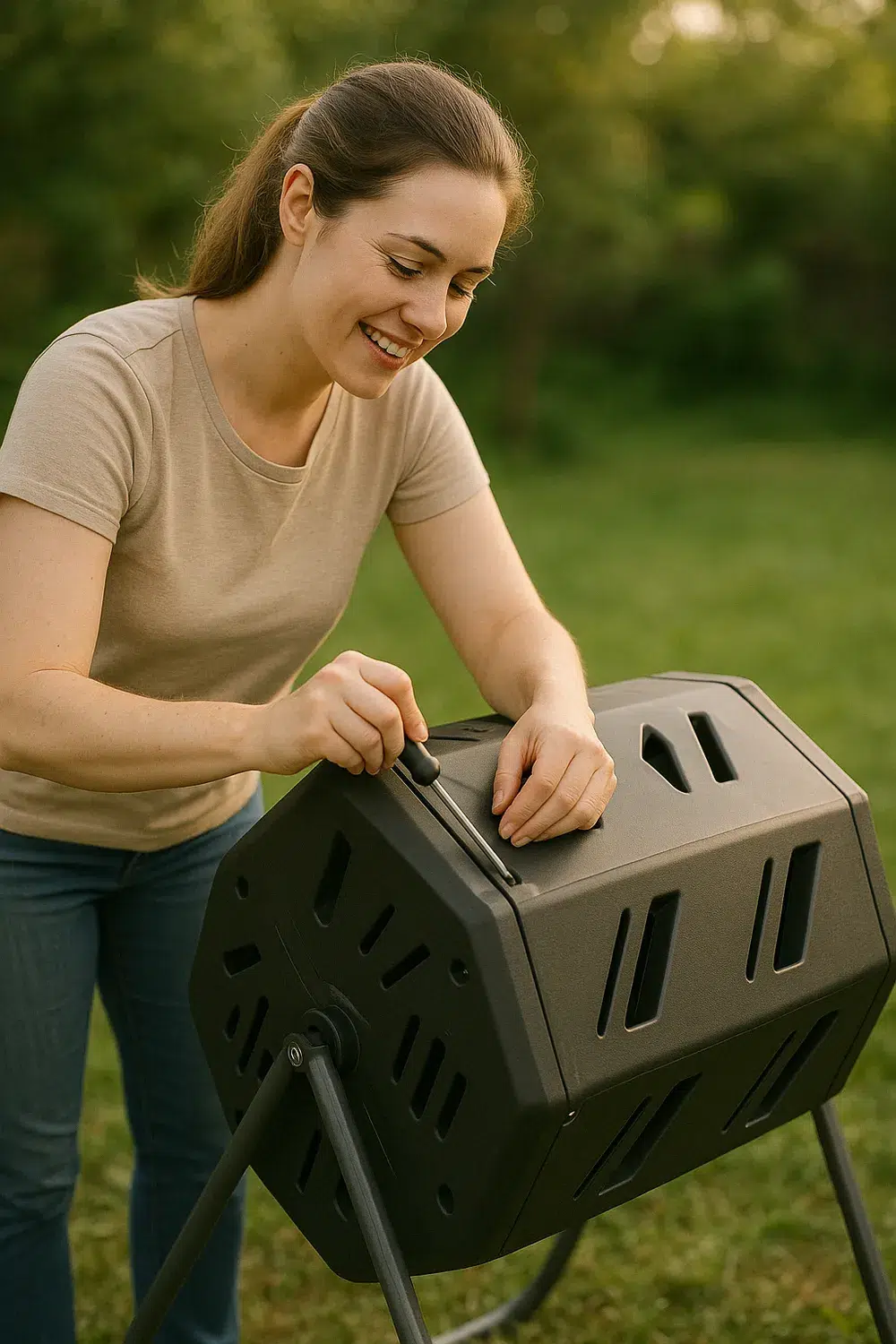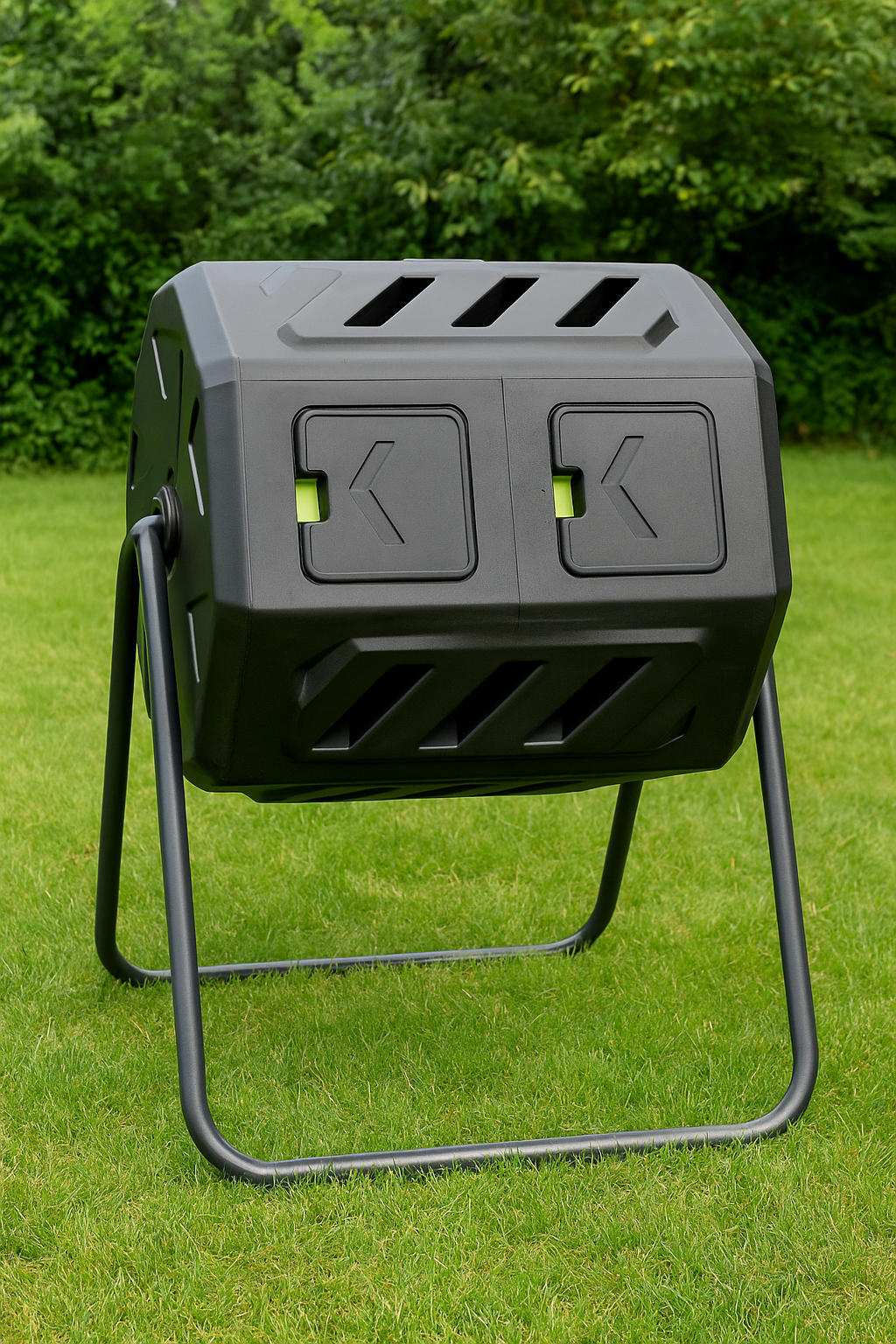Tumbler Composting for Beginners: Complete 5 Part Guide
Want to create nutrient-rich compost quickly and easily? A compost tumbler might be the perfect solution for efficient composting! This guide will walk you through everything you need to know to start composting in a tumbler, from choosing the best tumbler to troubleshooting common issues. Let’s get started with the basics of tumbler composting!
Table of Contents
Why Choose a Compost Tumbler?
Speed Comparison: tumbler vs. Traditional Methods
One of the biggest advantages of using a compost tumbler is speed. A compost tumbler can produce finished compost in as little as 4-6 weeks, compared to the 3-6 months it typically takes with traditional compost piles. This is because turning compost in a tumbler promotes faster decomposition. The increased airflow and mixing action of a tumbler speed up the compost process by creating the perfect environment for those beneficial microorganisms to do their best work. Now you can produce your compost fast!
Pest and Disease Resistance of tumblers
Another great benefit of using a compost tumbler is pest and disease resistance. A well-sealed tumbler makes it more difficult for pests like rodents and flies to access your compost pile. Because the tumbler can be sealed, it also helps to prevent the spread of disease by containing the compost materials and preventing them from coming into contact with the surrounding environment. If you start composting in a tumbler, you do not need to worry about pests and diseases. These composting systems are sealed for better odour-free composting, similar to a stationary compost bin.
Space Efficiency for Urban Composting
If you live in an urban area with limited space, a new tumbler is an excellent choice for your composting needs. Unlike traditional compost piles, tumblers don’t require a large yard or garden. You can easily place your tumbler on a balcony or patio, making it perfect for apartment dwellers or anyone with a small outdoor area. Choosing the right compost tumbler can allow for efficient composting even in tight spaces. It’s an easy way to reduce food waste and create valuable compost at home, even if you don’t have the space for traditional composting methods.
Tumbler Composting for Beginners: Quick Setup Guide

Choosing the Right Location for Your tumbler
To guarantee successful composting, choosing the right compost tumbler is crucial for successful composting. and its placement is key. Place your tumbler in a spot that gets partial shade, preventing it from overheating, especially during summer. Ensure the area is level and has good drainage to avoid water buildup around the base, which can hinder your composting needs. Using a compost tumbler can slow down the composting process. A convenient location near your garden or kitchen scraps source will make turning compost easier to manage when using an insulated tumbler. By carefully considering these factors, you’ll set yourself up for rich compost!
Layering Materials in Tumbler Composting for Beginners
Proper layering is important for decomposition. Start composting by adding a base layer of “browns” like shredded cardboard or dry leaves. Then, alternate layers of “greens” such as kitchen scraps with a compost starter to enhance decomposition. grass clippings or kitchen scraps. Aim for a 1:1 ratio of greens to browns to maintain a balanced carbon-to-nitrogen ratio. This will create an ideal environment for the microorganisms needed to decompose the compost materials effectively. This mixture makes for faster composting in a tumbler compost process that is odour-free.
Moisture Management in Your tumbler
Maintaining the right moisture level is critical for efficient tumbler composting. The compost pile should be damp but not waterlogged, ideally feeling like a wrung-out sponge. Too much moisture can lead to anaerobic conditions and foul odours, while too little will slow down the composting process. If the compost is too dry, add water gradually while turning compost to moisten it. This way, you can optimize your composting in a tumbler. use a compost heap to enhance your composting process. effectively, yielding nutrient-rich compost bins.rich compost.
Maintaining Your Compost tumbler
Optimal Rotation Frequency
Turning compost in your composting area, ensure you have adequate ventilation. tumbler every few days is vital to speed up the composting process. Regular rotation aerates the compost, providing the microorganisms with the oxygen they need to efficiently decompose organic matter. Aim to turn the tumbler at least every 3 days. This frequent turning of the compost tumbler helps aerate the pile. turning compost promotes faster decomposition and more finished compost that is also odour-free. When you start composting in a tumbler remember to rotate for effective tumbler composting.
Tracking Temperature for Effective Composting
Monitoring the temperature inside your compost tumbler is a great way to gauge the activity of the decomposition process. The ideal temperature range is between 100-130°F (38-54°C), indicating active decomposition by the beneficial microorganisms. If the temperature exceeds 160°F (71°C), the composting needs must be monitored closely. compost might be overheating, which can kill these microbes. Adjust by adding more “browns” or turning compost to cool it down. This helps ensure successful composting.
Troubleshooting Common Composting Issues
Even with the best efforts, tumbler composting can present challenges. Some common issues and their solutions are summarized below:
| Issue | Possible Solution for using a compost tumbler |
|---|---|
| Bad Smell | Add shredded paper or cardboard to your compost tumbler |
| Slow Decomposition in a compost tumbler | Boost with coffee grounds or grass clippings |
If you notice fruit flies, ensure all kitchen scraps are covered with a layer of “browns.” A small bit of knowledge can fix these challenges.
Adapting Your tumbler for Different Climates
Winter Composting Strategies
When winter arrives, start composting can be a challenge, but you can still compost using your tumbler! To keep the decomposition process going in winter, insulate your compost tumbler. Also, boost the amount of “browns,” like fallen leaves, to provide extra carbon, which helps to heat the compost pile. Location matters; positioning your tumbler in a sunny spot can help maintain efficient composting. With these winter strategies, you can speed up the composting process even in cold weather.
Summer Care for Your Compost tumbler
Summer heat can cause your compost tumbler to overheat and slow down the composting process, so get your compost ready for the growing season. turn the tumbler to cool it down. Move your composter to a shady spot and keep an eye on the moisture levels in the summer. By adapting your composting in a tumbler tumbler composting By following the practices for the summer, you can ensure your garden soil remains healthy. successful composting throughout the season.
Advanced tumbler Composting Techniques
Speeding Up the Decomposition Process
To speed up the composting process in your tumbler, chop your kitchen scraps into smaller pieces—less than 1 inch is ideal. This increases the surface area for composting in a tumbler microorganisms to break down the organic matter more quickly. Regularly turn the tumbler to ensure proper aeration, and maintain the correct moisture balance. Adding a handful of old compost to your new compost heap can introduce beneficial microorganisms, accelerating the decomposition. These small actions ensure you turn the compost regularly for better results. use a compost most effectively to ensure fast production of nutrient-rich compost.
Using Natural Accelerators to Enhance Compost Quality
Consider using natural accelerators to enhance the quality of your compost in your bin. While not specifically designed for tumbler composting, red flyies can accidentally find their way into your compost tumbler and boost compost quality. These worms will help break down organic matter, resulting in finer, more nutrient-rich finished compost. Keep adding “browns” and “greens” from scraps and yard to ensure the microorganisms decompose Using a compost tumbler can improve everything.
Harvesting and Reusing Your Compost Effectively
When it’s time to harvest your compost from your compost tumbler, use a ½-inch mesh screen to sift the composting area for finer material. finished compost from any unfinished bits. The sifted compost is ready to enrich your garden beds. Don’t toss the larger, unfinished pieces! You can return them to the tumbler to start a new batch or add compost to them to a larger tumbler. By efficiently harvesting and reusing compost materials, you will have more nutrient-rich compost.
FAQs
What do you put in a compost tumbler first?
When you start composting in a tumbler, begin with a layer of “browns” like shredded cardboard, dry leaves, or newspaper. Begin with a layer of browns when starting a compost tumbler. These carbon-rich materials create an airy base, aiding decomposition and preventing the compost pile from becoming too wet. This initial layer also helps absorb excess moisture from subsequent “greens,” ensuring a balanced composting process in your tumbler. compost process. So remember, browns first to start composting in a tumbler That’s right! Using a compost activator can help speed up the process. You can enhance your composting in a tumbler by adding more brown materials.
What not to put in a compost tumbler
Certain items should never go into your compost tumbler. Avoid adding certain materials, as listed below. Keep your kitchen scraps and yard waste compost separate!
| Materials to Avoid | Reason |
|---|---|
| Meat, dairy, oily foods, diseased plants, pet waste | Not suitable for composting; can negatively impact the quality of your finished compost. |
Should compost tumbler vents be open or closed?
The position of your compost tumbler’s vents depends on the moisture level and weather conditions. Generally, keep the vents open to promote airflow, which is vital for efficient composting and preventing anaerobic conditions. Adjust the vents based on what your compost pile needs.
| Condition | Vent Position is crucial for maintaining airflow in your composting area. |
|---|---|
| Compost too wet | Open |
| Heavy rain or winter | Closed compost bins are effective at maintaining temperature and moisture levels. |
Opening the vents helps compost dry out when it becomes too wet, improving the quality of your garden soil. During heavy rain or in winter, closing the vents can help retain heat and moisture, ensuring continuous decomposition.
Should I turn my compost tumbler every day?
While turning compost is essential, turning compost in your tumbler every day isn’t necessary. Optimal frequency for turning a compost tumbler is every 2-3 days. Regular turning provides the aeration needed for a compost heap to thrive. decomposition, but overdoing it can disrupt the microorganisms and slow down the composting process. Aim for a consistent schedule to speed up the composting process and maintain an odour-free environment. Frequent rotation ensures you use a compost system effectively and avoid overly compressed scraps and yard waste.
Are there any common mistakes to avoid when composting in a tumbler?
Several common mistakes can hinder tumbler composting. Neglecting the balance of “greens” and “browns” leads to imbalances in the compost pile. Overwatering can create anaerobic conditions, causing foul odours. Forgetting to turn the tumbler regularly can help to dry out the compost if it becomes too wet. slow down the composting process. Not chopping kitchen scraps into smaller pieces slows decomposition. Avoid these common errors: neglecting the balance of greens and browns, overwatering, forgetting to turn the compost tumbler, and not chopping kitchen scraps into smaller pieces. Avoiding these beginner errors will help you use a compost effectively and ensure successful composting.
Can a compost tumbler attract pests, and how can I prevent or manage them?
While compost tumblers are designed to be pest-resistant, they can attract pests if not managed properly. Make sure that you add new materials to your compost tumbler regularly. choose a tumbler that is pest resistant. To prevent pests, ensure all kitchen scraps are completely covered with a layer of “browns,” avoid adding meat, dairy, or oily foods, and ensure the compost tumbler is well-sealed. If fruit flyies appear, add a thick layer of shredded cardboard to suffocate them, while also enriching the composting area. Following these steps helps maintain a pest-free compost pile.
How do I select the right size and capacity for a compost tumbler based on my needs?
When choosing the right compost tumbler, consider your food waste volume and available space can be optimized by using an insulated tumbler. For a small household, a single-chamber compost tumbler might suffice. Larger households or those with extensive gardens should consider a A dual-chamber tumbler helps manage different stages of composting efficiently. model, allowing for continuous composting. Measure your available space to ensure the composter fits comfortably. When choosing a compost tumbler, consider food waste volume, available space, and garden needs. Assess the home compost bins can significantly improve your composting efficiency. needs of your garden to determine the ideal capacity of your compost tumbler, ensuring you use a compost effectively.
Kaleem,
www.greenlifehub.com

